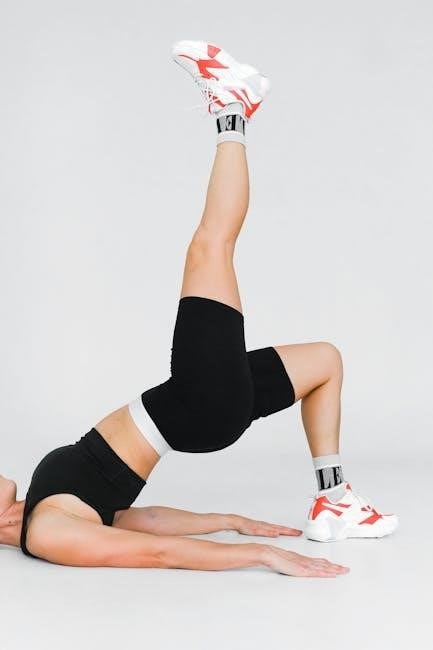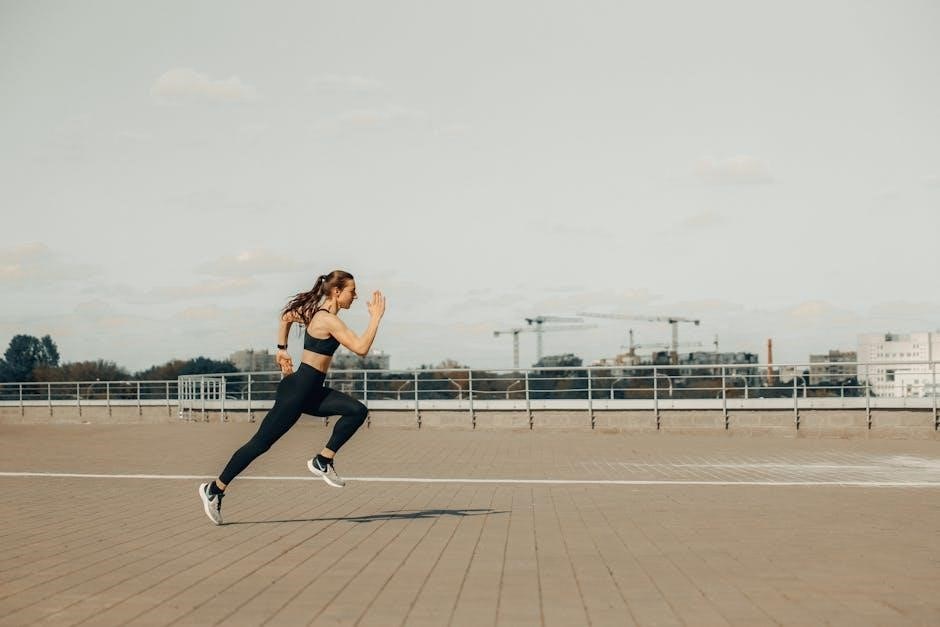Stretching the latissimus dorsi muscles is essential for improving flexibility, preventing injury, and reducing muscle soreness. Dynamic and static stretches target this large back muscle effectively, enhancing overall mobility and athletic performance.
Understanding the Latissimus Dorsi Muscle
The Latissimus Dorsi, commonly referred to as the “lats,” is the largest muscle in the upper body, spanning the lower back to the armpits. It plays a crucial role in movements like pulling, rowing, and swimming by facilitating adduction, extension, and internal rotation of the shoulder joint. Originating from the thoracic vertebrae, lumbar vertebrae, sacrum, and iliac crest, it inserts into the humerus bone. This broad muscle is essential for stabilizing the pelvis and lower back during activities. Its Latin name translates to “broadest of the back,” reflecting its expansive coverage. Understanding its anatomy helps in appreciating its function in posture and movement, making it vital for maintaining back health and enhancing athletic performance through proper stretching and strengthening exercises.

The Importance of Stretching the Latissimus Dorsi
Stretching the latissimus dorsi improves flexibility, reduces muscle soreness, prevents injuries, and enhances athletic performance by maintaining proper muscle function and range of motion.
Why Stretching is Crucial for Flexibility
Stretching the latissimus dorsi is vital for maintaining and improving flexibility. Tight lat muscles can limit range of motion, affecting activities like reaching, lifting, and athletic movements. Regular stretching enhances elasticity in the muscle fibers, allowing for better movement and posture. Over time, consistent stretching can break down adhesions and scar tissue, further promoting flexibility. Additionally, stretching reduces muscle tension, which can interfere with proper joint alignment and function. By incorporating both dynamic and static stretches, individuals can ensure their latissimus dorsi muscles remain supple, supporting overall mobility and reducing the risk of strain or injury during exercise or daily tasks.
Consequences of Tight Latissimus Dorsi Muscles
Tight latissimus dorsi muscles can lead to several issues, including reduced mobility and increased risk of injury. When the lats are overly tense, they can pull the pelvis and lower back out of alignment, causing discomfort and strain. This tension may also limit shoulder movement, making activities like overhead reaching or swimming more challenging. Additionally, tight lats can contribute to poor posture, such as a hunched or rounded upper back, which may lead to long-term spinal issues. Over time, chronic tightness can result in muscle imbalances, affecting overall athletic performance and increasing the likelihood of strains or tears during physical activity. Addressing tight lat muscles through stretching and strengthening exercises is essential to maintain proper muscle function and prevent these potential problems.

Types of Latissimus Dorsi Stretches
Latissimus dorsi stretches include dynamic and static exercises. Dynamic stretches involve movement, like arm swings, while static stretches, such as child’s pose, are held for extended periods. Both improve flexibility.
Dynamic Stretches for the Latissimus Dorsi
Dynamic stretches for the latissimus dorsi involve active movements that prepare the muscle for activity. One effective exercise is the arm swing: stand tall, swing arms forward and backward, then side to side. Another is the torso twist: with feet shoulder-width apart, twist the trunk while keeping the hips stable. These stretches enhance blood flow and range of motion, making them ideal before workouts or sports. Additionally, shoulder shrugs and circular arm movements can target the upper lats dynamically. Regular dynamic stretching improves flexibility and reduces injury risk, especially for athletes engaging in activities like rowing or swimming. Always perform these stretches smoothly and within a comfortable range to avoid strain.
Static Stretches for the Latissimus Dorsi
Static stretches for the latissimus dorsi are essential for improving flexibility and relieving tension. One effective stretch is the standing side stretch: reach one arm overhead, lean to the opposite side, and hold for 15-30 seconds. Another is the child’s pose, which stretches the lats while promoting relaxation. To perform, kneel on the floor, sit back onto your heels, and stretch your arms forward, lowering your chest toward the ground; Hold this position for 20-30 seconds. The seated lat stretch involves sitting on the floor with legs extended, leaning forward to reach your toes, and holding the stretch. Using a stability ball, place your hands on the ball, kneel behind it, and push it forward to stretch your lats. Static stretches are most effective after a workout when muscles are warm, helping to reduce soreness and improve range of motion.

Benefits of Regular Latissimus Dorsi Stretching
Regular stretching improves flexibility, reduces muscle soreness, and enhances athletic performance. It also prevents injuries by maintaining proper range of motion and relieving tightness in the latissimus dorsi muscles.
Improving Flexibility and Range of Motion
Regular stretching of the latissimus dorsi enhances flexibility and range of motion, crucial for everyday activities and athletic performance. Tight lats can limit movement, but targeted exercises like dynamic and static stretches help lengthen the muscle fibers, allowing for greater mobility. Improved flexibility reduces stiffness in the back and shoulders, making tasks such as reaching or twisting easier. Additionally, better range of motion supports proper posture and reduces the risk of muscle imbalances. Over time, consistent stretching can lead to long-term improvements in joint mobility and overall musculoskeletal health. This makes incorporating lat stretches into a daily routine beneficial for both fitness enthusiasts and individuals seeking to maintain functional movement.
Reducing Muscle Soreness and Pain
Stretching the latissimus dorsi is an effective way to alleviate muscle soreness and pain, particularly after intense workouts or prolonged periods of inactivity. Tight lats can lead to discomfort in the upper back, shoulders, and even lower back. By incorporating dynamic and static stretches, individuals can release tension in the muscle fibers, promoting relaxation and reducing stiffness. For example, dynamic stretches like arm swings and torso rotations help warm up the muscles, while static stretches, such as child’s pose or seated lat stretches, provide deep relief. Regular stretching also improves blood flow, which aids in muscle recovery and reduces the likelihood of soreness. Over time, consistent stretching can prevent chronic pain and enhance overall comfort, making it a vital practice for maintaining muscle health and mobility.
Preventing Injuries
Regular stretching of the latissimus dorsi muscles plays a crucial role in preventing injuries, especially for athletes or individuals engaging in activities that involve heavy lifting, rowing, or pulling motions. Tight or overactive lats can lead to imbalances in the shoulder and lower back, increasing the risk of strains or tears. Dynamic stretches, such as arm swings and torso rotations, prepare the muscles for activity by enhancing flexibility and range of motion. Static stretches, like child’s pose or seated lat stretches, help lengthen the muscle fibers, reducing tension and improving joint stability. Incorporating these stretches into a routine can strengthen the muscle-tendon connection, lowering the likelihood of overuse injuries. Additionally, proper stretching ensures better posture and movement mechanics, further safeguarding against potential harm during physical activities.
Enhancing Athletic Performance
Stretching the latissimus dorsi muscles is vital for athletes seeking to enhance performance. Flexible lats improve range of motion, allowing for more powerful movements in sports like swimming, rowing, and golf. Dynamic stretches before workouts, such as arm circles and torso twists, prepare the muscles for action, boosting efficiency and endurance. Static stretches after exercise, like the seated lat stretch, promote recovery by reducing muscle tightness. Enhanced flexibility in the lats also improves posture and reduces energy expenditure, enabling athletes to perform at higher intensities. Additionally, stretching prevents muscle imbalances, which are common in sports, ensuring optimal strength and coordination. Regular lat stretching routines contribute to better overall athleticism, making them an essential component of any training program aimed at maximizing performance and achieving peak physical condition.

Effective Exercises for the Latissimus Dorsi
Effective exercises include the standing side stretch, child’s pose, and lat stretch on a stability ball. These stretches improve flexibility, reduce muscle soreness, and enhance overall mobility, benefiting both athletes and individuals seeking better posture and reduced back pain.
Standing Side Stretch
The standing side stretch is an effective exercise for targeting the latissimus dorsi muscles. To perform this stretch, stand tall with your feet shoulder-width apart. Extend your arms overhead and interlock your fingers, ensuring your shoulders remain down and away from your ears. Slowly lean to one side, keeping your hips and knees stable, until you feel a gentle stretch in your lat muscles. Hold this position for 15-30 seconds, then return to the starting position and repeat on the other side. For a dynamic variation, gently twist your torso while leaning, enhancing the stretch. This exercise improves flexibility, posture, and reduces tension in the upper back. It is particularly beneficial for athletes involved in rowing, swimming, or other sports requiring strong lat engagement. Regular practice can also help prevent muscle imbalances and enhance overall mobility.
Child’s Pose
Child’s Pose, or Balasana, is a gentle and effective stretch for the latissimus dorsi muscles. To perform this pose, kneel on a mat with your knees wide apart and toes touching. Sit back onto your heels and stretch your arms forward, lowering your forehead to the ground. Hold this position for 15-30 seconds, breathing deeply to enhance the stretch. This pose not only targets the lats but also stretches the upper back and shoulders, promoting relaxation and flexibility. It is particularly beneficial for relieving tension in the latissimus dorsi after intense workouts or for improving posture. Child’s Pose is suitable for all fitness levels and can be modified by placing a pillow under the forehead for comfort. Regular practice helps reduce muscle soreness and enhances overall spinal mobility, making it a great addition to any stretching routine.
Lat Stretch on a Stability Ball
A Lat Stretch on a Stability Ball is an excellent way to target the latissimus dorsi muscles while improving flexibility and posture. To perform this stretch, kneel on the floor facing the stability ball. Place your hands on top of the ball and assume a “karate chop” position with your arms. Inhale deeply, then exhale as you bow forward, lowering your chest toward the ball. As you move, push the ball away from you, stretching your lats and upper back. Hold the stretch for 15-30 seconds, breathing naturally. This exercise allows for dynamic movement, making it effective for increasing elasticity in the lat muscles. Regular practice can help reduce tightness, improve spinal mobility, and enhance overall athletic performance. The stability ball provides support and allows for a controlled stretch, making it suitable for individuals of all fitness levels. Consistency is key for optimal results.
Seated Lat Stretch
The Seated Lat Stretch is a simple yet effective exercise for targeting the latissimus dorsi muscles. Sit on the floor with your legs extended straight in front of you. Reach forward with your arms, keeping them straight, and hold for 15-30 seconds. This stretch elongates the lat muscles, improving flexibility and reducing tension. Focus on maintaining a straight back and avoiding rounding of the shoulders. To enhance the stretch, gently lean forward from your hips rather than your neck. This exercise is particularly beneficial for individuals who spend extended periods sitting or engaging in activities that shorten the lat muscles. Regular practice can help alleviate tightness, improve posture, and reduce the risk of injury. It is also an excellent stretch for athletes to incorporate into their warm-up or cool-down routines to maintain optimal muscle elasticity and range of motion. Consistency is key for achieving long-term benefits.
Doorway Stretch
The Doorway Stretch is a convenient and effective way to target the latissimus dorsi muscles. Stand in a doorway with your hands placed on the doorframe at shoulder height. Lean forward slowly, keeping your arms straight, until you feel a gentle stretch in your chest and across your back. Hold this position for 15-30 seconds, breathing deeply to enhance the stretch. Avoid arching your back or using force, as this could lead to discomfort or injury. This stretch is ideal for improving flexibility and reducing muscle tension, especially after prolonged sitting or physical activity. It is also a great option for those with limited equipment, as it requires only a doorway. Regular practice of the Doorway Stretch can help maintain proper posture, reduce muscle soreness, and enhance overall mobility. Consistency is key to achieving long-term benefits for the latissimus dorsi muscles.

Injury Prevention and Rehabilitation
Preventing injuries involves dynamic and static stretches, while rehabilitation focuses on strengthening exercises and low-impact movements to restore latissimus dorsi function and mobility, ensuring proper muscle recovery and health.
Exercises to Prevent Latissimus Dorsi Injuries
Preventing latissimus dorsi injuries involves a combination of dynamic and static stretches, along with strengthening exercises. Dynamic stretches, such as arm swings and shoulder rotations, prepare the muscles for activity by increasing blood flow and flexibility. Static stretches, like the child’s pose and seated lat stretch, help lengthen the muscle fibers, reducing tightness and the risk of strains. Strengthening exercises, including rows and lat pulldowns, build muscle endurance and stability, making the lats more resilient to injury. Incorporating these exercises into a regular routine can significantly reduce the likelihood of latissimus dorsi injuries, especially for individuals engaged in sports or activities that involve heavy lifting or repetitive movements.
Rehabilitation Stretches Post-Injury
After a latissimus dorsi injury, gentle rehabilitation stretches are crucial to restore flexibility and strength. Begin with low-intensity exercises like shoulder extensions and seated lat stretches to promote healing. The child’s pose is an effective stretch to target the lats while minimizing strain. Using a stability ball, kneel and push the ball forward, holding the stretch for 15-30 seconds. Repeat this 2-3 times to gradually improve mobility. Incorporate deep breathing to relax the muscles during stretches. Avoid aggressive movements to prevent re-injury. Physical therapy exercises, such as latissimus dorsi contractions and gentle rotations, can also aid in recovery. Consistency is key to rebuilding muscle function and preventing future injuries. Always consult a physical therapist to tailor a rehabilitation plan suited to the severity of the injury.
Physical Therapy Exercises
Physical therapy exercises for the latissimus dorsi focus on restoring strength, flexibility, and proper muscle function. Gentle shoulder extensions and low-intensity stretches are often recommended to avoid overstraining the muscle. Using a stability ball, exercises like the lat stretch or elevated child’s pose can effectively target the lats while promoting relaxation. Deep breathing techniques during these exercises help reduce muscle tension and enhance the stretching benefits. Progress gradually to more dynamic movements, such as arm swings or shoulder rotations, to improve range of motion. Strengthening exercises, including latissimus dorsi contractions and resisted rows, are introduced as the muscle heals. Consistency and proper form are essential to ensure a full recovery and prevent future injuries. Always follow a personalized plan designed by a physical therapist to address specific injury needs and promote optimal muscle function.
Strengthening the Latissimus Dorsi
Strengthening the latissimus dorsi is crucial for enhancing upper body stability and improving overall athletic performance. Key exercises include pull-ups, seated rows, and deadlifts, which target the lats effectively. Incorporate resistance bands or weights to increase intensity. For beginners, assisted pull-ups or lat pulldowns are excellent starting points. Focus on slow, controlled movements to maximize muscle engagement. Strengthening the lats also enhances posture and reduces the risk of injury during physical activities. Consistency in these exercises promotes muscle balance and supports functional movements like lifting and rowing. Over time, a stronger latissimus dorsi contributes to better overall strength and mobility, making it essential for both athletes and individuals seeking improved physical fitness.

Tips for Effective Stretching

Hold stretches for 15-30 seconds and practice regularly for maximum flexibility. Focus on proper breathing and avoid bouncing to prevent injury. Consistency yields the best results;
Duration and Frequency of Stretching
For optimal results, hold each latissimus dorsi stretch for 15-30 seconds. This duration ensures the muscle reaches a relaxed state, enhancing flexibility. Aim to stretch 2-3 times per week, ideally after workouts when muscles are warm. Consistency is key for long-term improvements in range of motion and muscle elasticity. Overstretching can lead to injury, so balance is crucial. Incorporate both dynamic and static stretches into your routine, with dynamic movements before workouts and static holds after. Proper timing and repetition will help maintain healthy, flexible lat muscles, reducing the risk of tightness and pain.
Proper Breathing Techniques
Proper breathing is essential for effective latissimus dorsi stretching. Exhale slowly as you move into the stretch to allow the muscle to relax and lengthen. Avoid holding your breath, as this can increase muscle tension and reduce the stretch’s effectiveness. Instead, focus on deep, controlled breathing to enhance relaxation and maintain focus. Inhale before starting the stretch and exhale gradually as you deepen it, ensuring a steady flow of oxygen to the muscles. This technique helps reduce discomfort and maximizes the stretch’s benefits. By synchronizing your breath with the movement, you can achieve a safer and more effective stretch. Proper breathing also promotes mindfulness, helping you stay present and aware of your body’s response during the exercise.
Incorporating regular latissimus dorsi stretches into your routine offers numerous benefits, including enhanced flexibility, reduced muscle soreness, and improved athletic performance. Dynamic and static stretches, along with proper breathing techniques, ensure effective relaxation and lengthening of the muscle. Consistency is key to maintaining optimal range of motion and preventing injuries. By prioritizing these exercises, individuals can achieve a stronger, more flexible back, supporting overall physical health and wellness. Remember, stretching is a long-term investment in your body’s mobility and comfort.